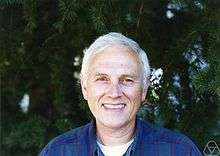Michael G. Crandall
| Michael G. Crandall | |
|---|---|
 | |
| Born |
November 29, 1940 (age 76) Baton Rouge, Louisiana, U.S. |
| Nationality | American |
| Occupation | Mathematics Professor (Emeritus) |
|
Scientific career | |
| Institutions | University of California, Santa Barbara |
| Alma mater | UC Berkeley |
| Doctoral students |
Lawrence Evans Panagiotis Souganidis |
| Notable awards | Leroy P. Steele Prize (1999) |
Michael Grain Crandall (born November 29, 1940, in Baton Rouge, Louisiana) is an American mathematician, specializing in differential equations.
Mathematical career
In 1962 Crandall earned a baccalaureate in engineering physics from Berkeley, changed to mathematics, earning a master's in 1964 and a PhD in 1965 under Heinz Cordes in Berkeley, with a thesis that solved a problem in celestial mechanics posed by Carl Ludwig Siegel; the thesis title is Two families of plane solutions of the four body problem. In 1965 he was an instructor at Berkeley, in 1966 an assistant professor at Stanford University and from 1969 at the University of California, Los Angeles (UCLA), where he was a professor from 1973 to 1976. From 1974 to 1984 he was also a professor at the Mathematics Research Center at the University of Wisconsin-Madison, from 1984 to 1990 as Hille-Professor of Mathematics. Since 1988 he has been a professor at the University of California, Santa Barbara. Crandall was several times a visiting professor at the University of Paris, where he received an honorary doctorate in 1999. He has been a professor at the University of California, Santa Barbara for the years leading up to his retirement. His legacy of contributions contains all but not limited to: Banach solutions in Euclidean spaces, Fourier transforms of planar variables, PDE concepts and iterations for sequence analysis, semigroup transform solutions, differential harmonic study of divergent hyperbole, physical transformations of finite Jacobian entities, unique harmonic populations in convergent contexts, application of abstract existence principles on non-linear contexts, normalized vector sequencing in multi-dimensional parallax geometries, and the mathematical equivalence study of topographical dis-similar nodes using traditional non-linear surfacing theories to produce distinct solutions in the realm of differential multi-variable applications.
Crandall works primarily on partial differential equations, e.g., with bifurcation theory, evolution equations, generation of semigroups of transformations on Banach spaces[1] and the theory of Hamilton-Jacobi equations. With Pierre-Louis Lions he did research on the viscosity solutions of partial differential equations.[2]
In 2000 he was elected a member of the American Academy of Arts and Sciences. In 1999 he received the Leroy P. Steele Prize. In 1974 he was an Invited Lecturer (on "Semigroups of nonlinear equations and evolution equations") at the International Congress of Mathematicians in Vancouver. In 2012 he became a fellow of the American Mathematical Society.[3]
Among his doctoral students is Lawrence C. Evans.
References
- ↑ Crandall, Thomas Liggett: Generation of semigroups of nonlinear transformations on general Banach spaces. In: American Journal of Mathematics. vol. 93, 1971, pp. 265-298. This paper is cited in the award presentation of the Steele Prize.
- ↑ Crandall, Lions: Viscosity of solutions of Hamilton-Jacobi equations. In: Transactions AMS. vol. 277, 1983, pp. 1-42. This paper is part of the research that won the Steele Prize.
- ↑ List of Fellows of the American Mathematical Society, retrieved November 10, 2012.
External links
- home page Crandall - UCSB Math. Dept.
- Steele Prize to Crandall, pdf-file, Notices AMS (76 kB)
- Michael G. Crandall at the Mathematics Genealogy Project